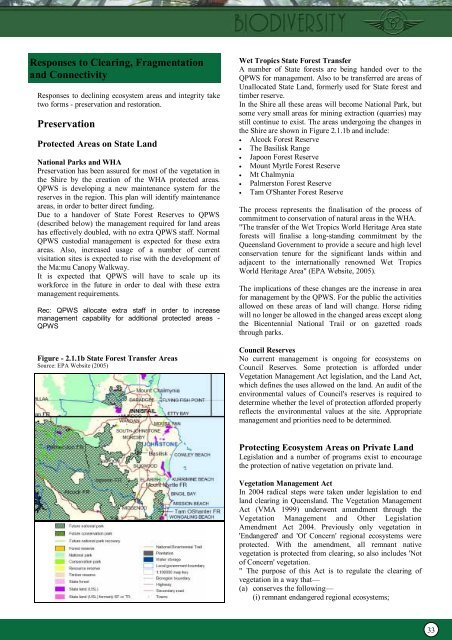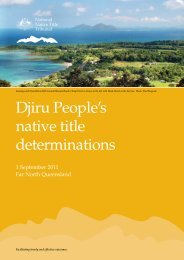Biodiveristy_State of Environment report - Mission Beach Cassowaries
Biodiveristy_State of Environment report - Mission Beach Cassowaries
Biodiveristy_State of Environment report - Mission Beach Cassowaries
- No tags were found...
Create successful ePaper yourself
Turn your PDF publications into a flip-book with our unique Google optimized e-Paper software.
Responses to Clearing, Fragmentationand ConnectivityResponses to declining ecosystem areas and integrity taketwo forms - preservation and restoration.PreservationProtected Areas on <strong>State</strong> LandNational Parks and WHAPreservation has been assured for most <strong>of</strong> the vegetation inthe Shire by the creation <strong>of</strong> the WHA protected areas.QPWS is developing a new maintenance system for thereserves in the region. This plan will identify maintenanceareas, in order to better direct funding.Due to a handover <strong>of</strong> <strong>State</strong> Forest Reserves to QPWS(described below) the management required for land areashas effectively doubled, with no extra QPWS staff. NormalQPWS custodial management is expected for these extraareas. Also, increased usage <strong>of</strong> a number <strong>of</strong> currentvisitation sites is expected to rise with the development <strong>of</strong>the Ma:mu Canopy Walkway.It is expected that QPWS will have to scale up itsworkforce in the future in order to deal with these extramanagement requirements.Rec: QPWS allocate extra staff in order to increasemanagement capability for additional protected areas -QPWSFigure - 2.1.1b <strong>State</strong> Forest Transfer AreasSource: EPA Website (2005)Wet Tropics <strong>State</strong> Forest TransferA number <strong>of</strong> <strong>State</strong> forests are being handed over to theQPWS for management. Also to be transferred are areas <strong>of</strong>Unallocated <strong>State</strong> Land, formerly used for <strong>State</strong> forest andtimber reserve.In the Shire all these areas will become National Park, butsome very small areas for mining extraction (quarries) maystill continue to exist. The areas undergoing the changes inthe Shire are shown in Figure 2.1.1b and include:• Alcock Forest Reserve• The Basilisk Range• Japoon Forest Reserve• Mount Myrtle Forest Reserve• Mt Chalmynia• Palmerston Forest Reserve• Tam O'Shanter Forest ReserveThe process represents the finalisation <strong>of</strong> the process <strong>of</strong>commitment to conservation <strong>of</strong> natural areas in the WHA."The transfer <strong>of</strong> the Wet Tropics World Heritage Area stateforests will finalise a long-standing commitment by theQueensland Government to provide a secure and high levelconservation tenure for the significant lands within andadjacent to the internationally renowned Wet TropicsWorld Heritage Area" (EPA Website, 2005).The implications <strong>of</strong> these changes are the increase in areafor management by the QPWS. For the public the activitiesallowed on these areas <strong>of</strong> land will change. Horse ridingwill no longer be allowed in the changed areas except alongthe Bicentennial National Trail or on gazetted roadsthrough parks.Council ReservesNo current management is ongoing for ecosystems onCouncil Reserves. Some protection is afforded underVegetation Management Act legislation, and the Land Act,which defines the uses allowed on the land. An audit <strong>of</strong> theenvironmental values <strong>of</strong> Council's reserves is required todetermine whether the level <strong>of</strong> protection afforded properlyreflects the environmental values at the site. Appropriatemanagement and priorities need to be determined.Protecting Ecosystem Areas on Private LandLegislation and a number <strong>of</strong> programs exist to encouragethe protection <strong>of</strong> native vegetation on private land.Vegetation Management ActIn 2004 radical steps were taken under legislation to endland clearing in Queensland. The Vegetation ManagementAct (VMA 1999) underwent amendment through theVegetation Management and Other LegislationAmendment Act 2004. Previously only vegetation in'Endangered' and 'Of Concern' regional ecosystems wereprotected. With the amendment, all remnant nativevegetation is protected from clearing, so also includes 'Not<strong>of</strong> Concern' vegetation." The purpose <strong>of</strong> this Act is to regulate the clearing <strong>of</strong>vegetation in a way that—(a) conserves the following—(i) remnant endangered regional ecosystems;33



